中山大学生化上考试往年试题完整版
中山大学生化真题专项整理(含答案)9脂代谢.doc
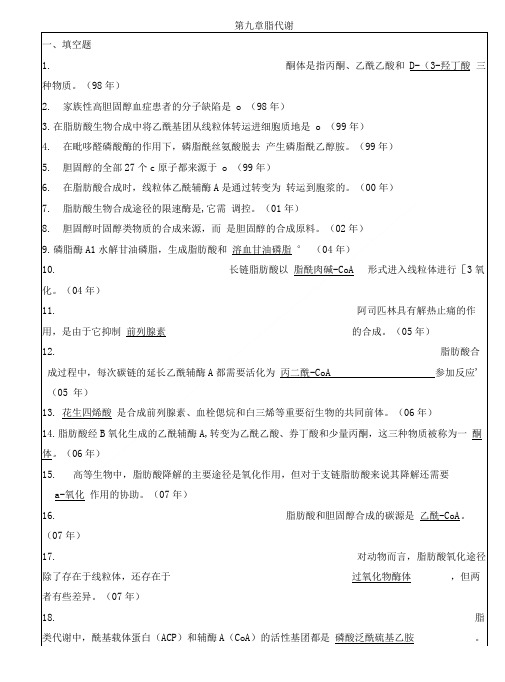
第九章脂代谢一、填空题1.酮体是指丙酮、乙酰乙酸和D-(3-羟丁酸三种物质。
(98年)2.家族性高胆固醇血症患者的分子缺陷是o (98年)3.在脂肪酸生物合成中将乙酰基团从线粒体转运进细胞质地是o (99年)4.在毗哆醛磷酸酶的作用下,磷脂酰丝氨酸脱去产生磷脂酰乙醇胺。
(99年)5.胆固醇的全部27个c原子都来源于o (99年)6.在脂肪酸合成时,线粒体乙酰辅酶A是通过转变为转运到胞浆的。
(00年)7.脂肪酸生物合成途径的限速酶是,它需调控。
(01年)8.胆固醇时固醇类物质的合成来源,而是胆固醇的合成原料。
(02年)9.磷脂酶A1水解甘油磷脂,生成脂肪酸和溶血甘油磷脂° (04年)10.长链脂肪酸以脂酰肉碱-CoA 形式进入线粒体进行[3氧化。
(04年)11.阿司匹林具有解热止痛的作用,是由于它抑制前列腺素的合成。
(05年)12.脂肪酸合成过程中,每次碳链的延长乙酰辅酶A都需要活化为丙二酰-CoA 参加反应' (05 年)13.花生四烯酸是合成前列腺素、血栓偲烷和白三烯等重要衍生物的共同前体。
(06年)14.脂肪酸经B氧化生成的乙酰辅酶A,转变为乙酰乙酸、券丁酸和少量丙酮,这三种物质被称为一酮体。
(06年)15.高等生物中,脂肪酸降解的主要途径是氧化作用,但对于支链脂肪酸来说其降解还需要a-氧化作用的协助。
(07年)16.脂肪酸和胆固醇合成的碳源是乙酰-CoA 。
(07年)17.对动物而言,脂肪酸氧化途径除了存在于线粒体,还存在于过氧化物酶体,但两者有些差异。
(07年)18.脂类代谢中,酰基载体蛋白(ACP)和辅酶A(CoA)的活性基团都是磷酸泛酰硫基乙胺。
(07 年)19.脂肪酸合成的限速步骤是丙二单酰CoA的生成。
(08年)20.中和1克油脂中的游离脂肪酸所需的氢氧化钾毫克数称为皂化值。
(10年)三、名词解释21.脂肪酸b氧化(00年)四、判断题22.()肝脏合成胆固醇的作用不受食物中胆固醇的抑制。
中山大学生命科学院生物化学试题答案与评分标准(2006秋季,A卷)

生物化学I(2006年秋季学期, A卷)I.简答题(共25小题,超过60分以60分计入总分)1.哪些标准氨基酸含两个手性碳原子?写出它们的Fisher投影式。
2.为什么SDS变性电泳可以估算蛋白质的分子量?3.Mass spectroscopy在生物大分子研究中有什么应用?4.-Keratin、Collagen、Silk fibroin的二级结构和氨基酸组成有何特点?5.根据二级结构的组成和排列可将蛋白质结构分为哪些类型?6.蛋白质in vivo条件下的折叠有哪些辅助因子?7.蛋白质在与其他分子的相互作用中发挥作用,这种相互作用有何特点?8.哪些因素可以导致Hemoglobin与O2的亲和力增加?9.图示抗体的一般结构(包括结构域及可能的二硫键)。
10.构成肌肉粗丝和细丝的蛋白分子有哪些,各有什么功能?11.写出蛋白质氨基酸测序的基本步骤。
12.什么是酶催化的过渡态理论?列出你所知道的支持证据?13.酶的可逆抑制剂有几类?它们的抑制动力学各有何特点?14.酶在体内的活性是如何受到调控的?15.淀粉与纤维素的结构有何区别?16.细胞膜表面的Glycoprotein和Glycolipid有哪些生物学功能?17.细胞内的DNA可能会出现哪些异常结构,他们有什么生物学意义?18.膜脂的分类及其结构特点19.生物膜的功能有哪些?20.膜蛋白以哪些方式参与生物膜的构成?21.图示secondary active transport,uniport,symport,antiport. 22.Acetylcholine receptor通道是如何控制开关的?23.K+离子通道是如何对通过的离子进行选择的?24.膜电位是怎样控制Na+通道开关的(可图示并说明)?25.Ca2+泵和Na+-K+泵的异同点。
II. You have a crude lysate sample containing a mixture of six proteins (1, 2, 3, 4, 5, and β-galactosidase). Some characteristics of these proteins are shown in the table below. Give an available procedure of purifying β-galactosidase.Protein Concentration of ammoniumsulfate required forprecipitationMolecularWeight(kDa)Isoelectricpoint (pI)145% 38 3.7 280% 22 4.8 365% 14 5.3 420% 75 6.8 530% 55 9.5 -galactosidase45% 115 5.3III. You are working on a compound as a potential drug that inhibits anoverproduced enzyme whose uncontrolled activity leads to uncontrolled cell proliferation (cancer). A steady-state kinetic analysis of the enzyme-catalyzed reaction was carried out, with velocities measured as a function of the concentration of the substrate in the absence and in the presence of 10 nM inhibitor. The results of the kinetics experiment are plotted for you below. Please answer the following questions.1. What type of inhibitor is this compound (be as specific as you can)?enzyme, S denoting substrate, I denoting inhibitor; for example: ).2. Calculate the K m , K cat in the absence of inhibitor and K m app , K cat app in thepresence of inhibitor (app denoting apparent. The total concentration of enzyme is 2nM).3. Calculate the inhibitor constant K I .生物化学I (2006年秋季学期, A 卷)I .1.苏氨酸 Thr 【1′】 【2′】;异亮氨酸 Ile 【1′】 【2′】E+S ES E+P2.① SDS 能够与蛋白质结合,导致蛋白质变性。
中山大学生化真题专项整理(含答案)2脂类和生物膜3.doc

第二章脂类、生物膜、跨膜运输和信号转导20.(")血浆脂蛋白中,低密度脂蛋白负责把胆固醇运送到肝外组织。
(04年)31.为什么说低密度脂蛋白(LDL)中的胆固醇是“bad cholesterol",而高密度脂蛋白(HDD 中的胆固醇是“good cholesterol" ? (07 年)Microvilli Epithelial cell Glucose Bloo d Basal surface \ Apical surface Intestinal lumen - •• 2IC 如•• C ATPaseGlucoseO —M 二.-.Glucose uniporter Na'gluE^^ElUT2symporter 到静息状态。
35. 根据下图说明葡萄糖在小肠被吸收进入血液循环的机制。
(12年)答:小肠肠壁细胞有两个面,其中一面作为肠内毛细血管的外壁,上有Na/K 泵及葡萄糖自由扩散 通道,而另一面面向小肠空间,上面有大量绒毛状的突起,在突起处有Na/葡萄糖协同转运载体。
首先,小肠肠壁细胞通过Na/K 泵,每运转一次将3个Na 离子泵出细胞,两个K 离子泵入细胞,建立起 细胞外正内负的膜电位,使得细胞内带负电荷,细胞外带正电荷且具有很高的Na 离子浓度。
而处于 小肠空间…面上的Na/葡萄糖协同转运载体,结合小肠中的2个Na 离了及1个葡萄糖分子利用小肠 中与小肠肠壁细胞内的Na 离子浓度差,将Na 离子及葡萄糖分子转运进入小肠肠壁细胞,进入细胞中 的2离子很快又被血管壁面的Na/K 泵泵至血液中,而进入的葡萄糖亦很快由葡萄糖扩散通道进入血 液,细胞内回复到初始状态,开始下一轮循环。
在这种机制下,葡萄糖由小肠进入血液循环。
36. 简述第二信使的主要类别及其作用机制。
(12年)答:细胞内有5种最重要的第二信使:cAMP 、cGMP 、DAG 、IP3及Ca2+。
中山大学生化资料中山大学生命科学院生物化学试题答案与评分标准.doc
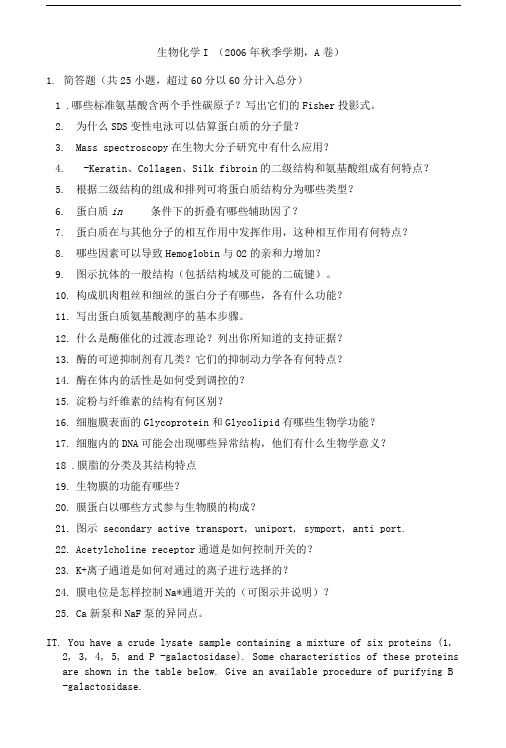
生物化学I (2006年秋季学期,A卷)1.简答题(共25小题,超过60分以60分计入总分)1 .哪些标准氨基酸含两个手性碳原子?写出它们的Fisher投影式。
2.为什么SDS变性电泳可以估算蛋白质的分子量?3.Mass spectroscopy在生物大分子研究中有什么应用?4.-Keratin、Collagen、Silk fibroin的二级结构和氨基酸组成有何特点?5.根据二级结构的组成和排列可将蛋白质结构分为哪些类型?6.蛋白质in条件下的折叠有哪些辅助因了?7.蛋白质在与其他分子的相互作用中发挥作用,这种相互作用有何特点?8.哪些因素可以导致Hemoglobin与O2的亲和力增加?9.图示抗体的一般结构(包括结构域及可能的二硫键)。
10.构成肌肉粗丝和细丝的蛋白分子有哪些,各有什么功能?11.写出蛋白质氨基酸测序的基本步骤。
12.什么是酶催化的过渡态理论?列出你所知道的支持证据?13.酶的可逆抑制剂有几类?它们的抑制动力学各有何特点?14.酶在体内的活性是如何受到调控的?15.淀粉与纤维素的结构有何区别?16.细胞膜表面的Glycoprotein和Glycolipid有哪些生物学功能?17.细胞内的DNA可能会出现哪些异常结构,他们有什么生物学意义?18 .膜脂的分类及其结构特点19.生物膜的功能有哪些?20.膜蛋白以哪些方式参与生物膜的构成?21.图示 secondary active transport, uniport, symport, anti port.22.Acetylcholine receptor通道是如何控制开关的?23.K+离子通道是如何对通过的离子进行选择的?24.膜电位是怎样控制Na*通道开关的(可图示并说明)?25.Ca新泵和NaF泵的异同点。
IT. You have a crude lysate sample containing a mixture of six proteins (1, 2, 3, 4, 5, and P -galactosidase). Some characteristics of these proteins are shown in the table below. Give an available procedure of purifying B -galactosidase.I.1.苏氨酸Thrtl7COO—COO-H3N-C-HH-C-OHch3H3N-C-H【2’】;异芫氨酸He [ 1' H—C—CHsCH2CH3【2'】1 45% 3S 3.72 80% 22 4.83 65% 14 5.34 20% 75 6.85 30% 55 9.5-galactosidase 45% 115 5.3III.You are working on a compound as a potential drug that inhibits an overproduced enzyme whose uncontrolled activity leads to uncontrolled cell proliferation (cancer). A steady-state kinetic analysis of theenzyme-catalyzed reaction was carried out, with velocities measured as a function of the concentration of the substrate in the absence and in the presence of 10 nM inhibitor. The results of the kinetics experiment are plotted for you below. Please answer the following questions.1.What type of inhibitor is this compound (be as specific as you can)?Show the diagram of the inhibitor" s mechanism (by E denoting enzyme, S denoting substrate, E+S §益】ot帛走+ P inhibitor; forexample: ).2.Calculate the K ni, K cat in the absence of inhibitor and K」叫,K cat app inthe presence of inhibitor (app denoting apparent. The totalconcentration of enzyme is 2nM).3.Calculate the inhibitor constant K h生物化学I (2006年秋季学期,A卷)2.①SDS能够与蛋白质结合,导致蛋白质变性。
中山大学生物化学(一)真题
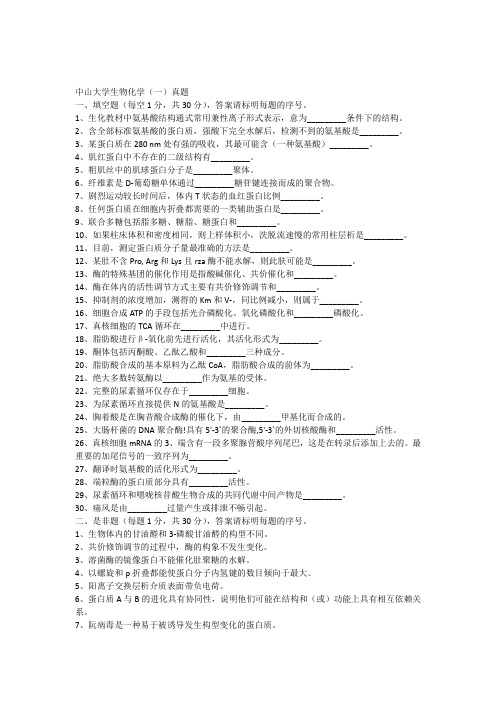
中山大学生物化学(一)真题一、填空题(每空1分,共30分),答案请标明每题的序号。
1、生化教材中氨基酸结构通式常用兼性离子形式表示,意为_________条件下的结构。
2、含全部标准氨基酸的蛋白质,强酸下完全水解后,检测不到的氨基酸是_________。
3、某蛋白质在280 nm处有强的吸收,其最可能含(一种氨基酸)_________。
4、肌红蛋白中不存在的二级结构有_________。
5、粗肌丝中的肌球蛋白分子是_________聚体。
6、纤维素是D-葡萄糖单体通过_________糖苷键连接而成的聚合物。
7、剧烈运动较长时间后,体内T状态的血红蛋白比例_________。
8、任何蛋白质在细胞内折叠都需要的一类辅助蛋白是_________。
9、联合多糖包括脂多糖、糖脂、糖蛋白和_________。
10、如果柱床体积和密度相同,则上样体积小,洗脱流速慢的常用柱层析是_________。
11、目前,测定蛋白质分子量最准确的方法是_________。
12、某肚不含Pro, Arg和Lys且rza酶不能水解,则此肤可能是_________。
13、酶的特殊基团的催化作用是指酸碱催化、共价催化和_________。
14、酶在体内的活性调节方式主要有共价修饰调节和_________。
15、抑制剂的浓度增加,测得的Km和V-,同比例减小,则属于_________。
16、细胞合成ATP的手段包括光合磷酸化、氧化磷酸化和_________磷酸化。
17、真核细胞的TCA循环在_________中进行。
18、脂肪酸进行β-氧化前先进行活化,其活化形式为_________。
19、酮体包括丙酮酸、乙酞乙酸和_________三种成分。
20、脂肪酸合成的基本原料为乙酞CoA,脂肪酸合成的前体为_________。
21、绝大多数转氨酶以_________作为氨基的受体。
22、完整的尿素循环仅存在于_________细胞。
23、为尿素循环直接提供N的氨基酸是_________。
中山生化真题02-09
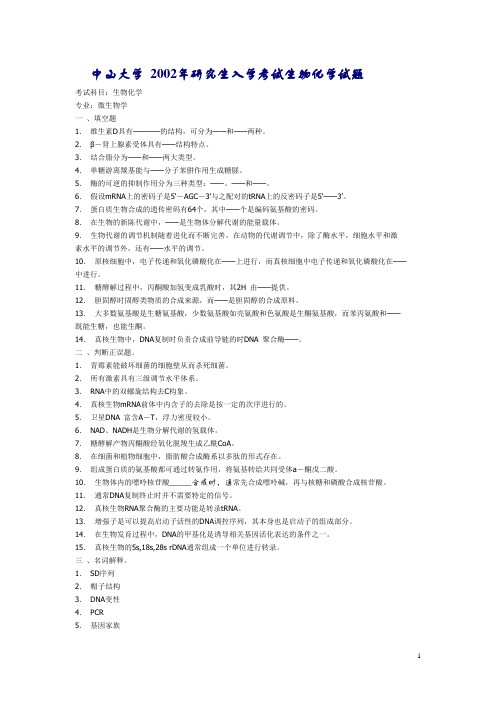
中山大学2002年研究生入学考试生物化学试题考试科目:生物化学专业:微生物学一、填空题1.维生素D具有————的结构,可分为——和——两种。
2.β-肾上腺素受体具有——结构特点。
3.结合脂分为——和——两大类型。
4.单糖游离羰基能与——分子苯肼作用生成糖脎。
5.酶的可逆的抑制作用分为三种类型:——、——和——。
6.假设mRNA上的密码子是5‘-AGC-3’与之配对的tRNA上的反密码子是5‘——3’。
7.蛋白质生物合成的遗传密码有64个,其中——个是编码氨基酸的密码。
8.在生物的新陈代谢中,——是生物体分解代谢的能量载体。
9.生物代谢的调节机制随着进化而不断完善。
在动物的代谢调节中,除了酶水平,细胞水平和激素水平的调节外,还有——水平的调节。
10.原核细胞中,电子传递和氧化磷酸化在——上进行,而真核细胞中电子传递和氧化磷酸化在——中进行。
11.糖酵解过程中,丙酮酸加氢变成乳酸时,其2H 由——提供。
12.胆固醇时固醇类物质的合成来源,而——是胆固醇的合成原料。
13.大多数氨基酸是生糖氨基酸,少数氨基酸如亮氨酸和色氨酸是生酮氨基酸,而苯丙氨酸和——既能生糖,也能生酮。
14.真核生物中,DNA复制时负责合成前导链的时DNA 聚合酶——。
二、判断正误题。
1.青霉素能破坏细菌的细胞壁从而杀死细菌。
2.所有激素具有三级调节水平体系。
3.RNA中的双螺旋结构去C构象。
4.真核生物mRNA前体中内含子的去除是按一定的次序进行的。
5.卫星DNA 富含A-T,浮力密度较小。
6.NAD、NADH是生物分解代谢的氢载体。
7.糖酵解产物丙酮酸经氧化脱羧生成乙酰CoA。
8.在细菌和植物细胞中,脂肪酸合成酶系以多肽的形式存在。
9.组成蛋白质的氨基酸都可通过转氨作用,将氨基转给共同受体a-酮戊二酸。
10.生物体内的嘌呤核苷酸__________合成时,通常先合成嘌呤碱,再与核糖和磷酸合成核苷酸。
11.通常DNA复制终止时并不需要特定的信号。
中山大学0310生物化学真题

中山高校 2003年探讨生入学考试生物化学试题一、填空题1.糖肽的两种主要连接键为——和——。
2.淀粉与碘反响呈紫蓝色,而糖原遇碘呈——色。
3.蛋白质二级构造主要有——和——两类。
4.蛋白质分子是由氨基酸通过肽键连接成多肽链,而DNA 分子由核苷酸通过——键连接成多核苷酸。
5.氨基酸的共有代谢途径有——和——。
6.假设tRNA上的反密码子是GGC,它可识别的密码子为GCC和——。
7.变性温度与DNA分子中的G-C含量成——关系8.具有催化活性的核算称为——。
9.三羧酸循环的限速酶是——。
10.原核细胞蛋白质合成中第一个被掺入的氨基酸是——。
11.乙酰CoA进一步氧化须要生物素和——作协助因子。
12.E.coli参与错配修复的是DNA聚合酶——。
13.tRNA基因启动子最重要的特征是——。
14.真核生物中,负责合成5SrRNA是RNA聚合酶——。
15.分子伴侣通常具有——酶活性。
16.真核mRNA上的加尾信号序列是——。
17.能互补和杂交于某一些基因产物,并能抑制其功能的RNA分子称——。
二、推断正误题。
1.糖链的合成无模板,糖基依次由基因编码的转移酶确定。
2.自然界常见的不饱和脂肪酸多具有反式构造。
3.同工酶各自对同一底物的米氏常数一样或相像。
4.汤圆合成的关键酶是磷酸化酶。
5.尿素是蛋白质的变性剂,高浓度尿素可拆开蛋白质分子中的二硫键。
6.对于提纯的DNA样品,测得OD260/OD280<1.8则说明样品中由RNA 残留。
7.由于酶反响的速度较快,因此酶反响的温度系数高于一般化学反响的温度系数。
8.一般的PCR反响不能扩增单链DNA。
9.目前发觉的修饰核苷酸大多存在于tRNA分子中。
10.转铁蛋白是一种糖蛋白。
三、名词说明。
1.蛋白聚糖2.生物膜3.透析4.构造域(Domain)5.核酸分子杂交6.同工酶7.开放读码框(ORF)__________8.顺式作用元件四、问答题1.生物体中脂类化合物由哪些主要特征?2.简述原核生物和真核生物在蛋白质合成过程的主要异同。
中山大学生化真题专项整理(含答案)6维生素、激素和抗生素.doc

第六章维生素、激素和抗生素一、填空题1.生物素是活化的崩基载体。
(98年)2.转氨酶的辅酶是磷酸的哆醛。
(98年)3.辅酶A通常作为酰基载体。
(98年)4.维生素B6 通过参与构成转氨酶的辅酶协助氨基酸的转移。
(99年)5.类固醇类激素包括雄性激素、雌性激素、孕激素(糖皮质激素、肾上腺皮质激素)等(00年)6.维生素D具有类固醇的结构,可分为V D3和V—两种。
(02年)7.P —肾上腺素受体具有7次跨膜结构特点。
(02年)8.乙酰CoA进一步氧化需要生物素和硫辛酸作辅助因子。
(03年)9.辅酶Q是线粒体内膜呼吸链的载体。
(04年)10.肾上腺素主要生理功能为,其机制是通过cAMP激活PKA 完成对靶细胞的作用。
(04年)11.胰岛素等激素的受体以及上皮或表皮生长因子的受体都是一种酪氨酸蛋白激酶。
(04 年)12.生物素是活化二氧化碳的载体,通常作为毛化酶的辅酶。
(05年)13.磺胺药物之所以能抑制细菌生长,是因为它是组成叶酸所需的对氨基苯甲酸的结构类似物。
14.胰岛素是体内唯一降低血糖的激素,也是唯一同时促进糖原、脂肪和蛋白质合成的激素。
(06年)15.氯霉素可抑制肽基转移酶酶的活性,从而抑制蛋白质的合成.(08年)16.甲基、甲烯基、甲焕基及亚氨甲基统称为一碳单位。
(09年)17.机体内甲基化反应中甲基的主要苴接供体是o (10年)18.转氨酶和脱梭酶的辅酶都是磷酸毗哆醛。
(10年)19.机体内与激素合成有关的维生素有维生素A和Vp (10年)20.胰腺激素可调节葡萄糖和的存储与释放。
(10年)21.在细胞内传递激素效应的物质称为o (11年)22.生物体内的维生索C和维生素被称为天然抗氧化剂。
(11年)23.人体内的激素在发挥其调节作用后主要在肝内被分解转化,这一过程称为激素的灭活(12 年)24.生长因子主要有内分泌,旁分泌和自分泌等三种作用方式。
(12年)25.有些肽类激素能促进蛋白质的生物合成是因为细胞内的cAMP浓度提高,激活了蛋白激酶。
中山大学生化真题专项整理(含答案)4酶3.doc
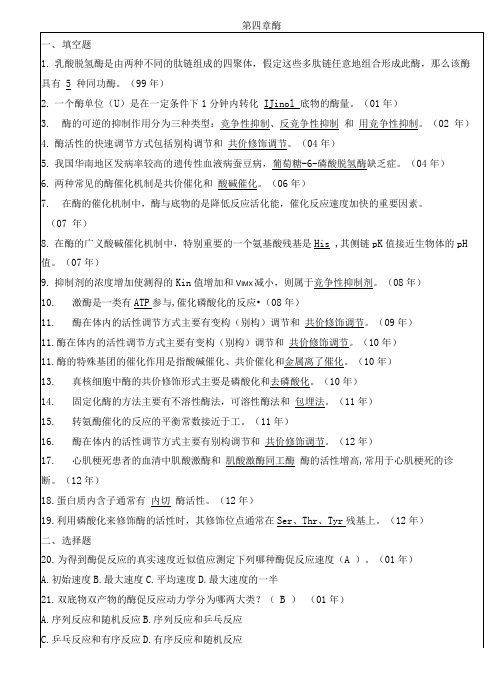
10.激酶是一类有ATP参与,催化磷酸化的反应•(08年)
11.酶在体内的活性调节方式主要有变构(别构)调节和共价修饰调节。(09年)
11.酶在体内的活性调节方式主要有变构(别构)调节和共价修饰调节。(10年)
11.酶的特殊基团的催化作用是指酸碱催化、共价催化和金属离了催化。(10年)
不一定。
33.(V)非竞争性抑制的酶反应中,Vmax变小,Km不变。(04年)
正确。
34.(V)酶的最适pH与酶的等电点是两个不同的概念,但两者之间有相关性,两个数值通常比较接 近或相同。(04年)
正确。
35.(")对于一个酶而言,其过渡态的底物类似物与底物相比较,是更有效的竞争性抑制剂。(04
年)
第四章酶
一、填空题
1.乳酸脱氢酶是由两种不同的肽链组成的四聚体,假定这些多肽链任意地组合形成此酶,那么该酶 具有5种同功酶。(99年)
2.一个酶单位(U)是在一定条件下1分钟内转化IJinol底物的酶量。(01年)
3.酶的可逆的抑制作用分为三种类型:竞争性抑制、反竞争性抑制和用竞争性抑制。(02年)
断。(12年)
18.蛋白质内含子通常有内切酶活性。(12年)
19.利用磷酸化来修饰酶的活性时,其修饰位点通常在Ser、Thr、Tyr残基上。(12年)
二、选择题
20.为得到酶促反应的真实速度近似值应测定下列哪种酶促反应速度(A)。(01年)
A.初始速度B.最大速度C.平均速度D.最大速度的一半
21.双底物双产物的酶促反应动力学分为哪两大类?(B ) (01年)
不改变。
51.(V)原核细胞中酶共价修饰形式主要是核昔酰化和脱核首酰化。(10年) 正确。
中山大学生化真题专项整理(含答案)7代谢总论、生物氧化和生物能学.doc
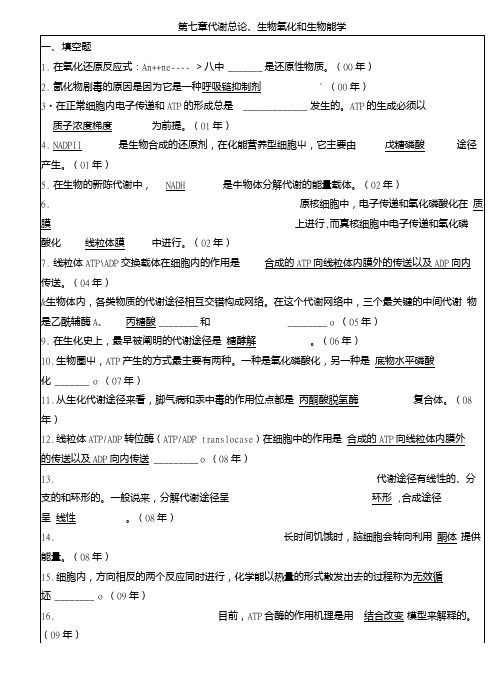
第七章代谢总论、生物氧化和生物能学三、名词解释19.光合作用(00年)20.呼吸链(电子传递链)(01年)四、判断题21.()氧化物合一氧化碳可以抑制电子由细胞色素a合a.3向02的传递。
(99年)22.()与牛物氧化作用相伴而牛的磷酸化作用称为氧化磷酸化作用(00年)23.(T )寡霉素通过抑制线粒体内膜上的ATP合成酶而干扰ATP的生成。
(01年)24.( F )NAD、NADH是生物分解代谢的氢载体。
(02年)25.( F )在正常呼吸的线粒体中,还原程度最高的细胞色素是细胞色素观3。
(04年)26.( T )寡霉素是线粒体ATP合成酶的抑制剂。
(04年)27.( F )生物体所需的能量都来源于太阳能。
(06年)2& ( T )一般生物大分子越稳定,表明其分子中的化学键具有更高的化学能。
(06年)29.( T )毒蘑菇中含有多种毒素,其中鹅膏毒素毒性强,作用快,通常吃后当天可致成年人死亡。
30.( F )无效循环指的是互逆的产能和耗能过程同时进行,ATP以热量形式散发,这种现象在机体内没有任何生理意义(07年)31.( F )胞浆的NADH能量通过线粒体内膜进入线粒体,然后被氧化产能。
(08年)32.( F )目前的进化理论认为,线粒体和叶绿体都起源于内共生细菌。
(08年)33.( T )对实验大鼠注射解偶联剂,如DNP时,可能会引起体温升高。
(08年)34.( T )假设鱼藤酮和抗霉索A在阻断各自作用的电子传递链位点的效率是相同的,鱼藤酮的毒性会更大。
(09年)35.( F )DNP (2, 4-dinitrophenol,2, 4-二硝基苯酚)是ATP合酶的抑制剂,可抑制ATP合成。
(09 年)36.( F )解偶联剂可抑制和呼吸链的电子传递。
(09年)37.( F )分解代谢和合成代谢通常是同一反应的逆转,其代谢反应也是可逆的。
(10年)38.( F )在高等植物中,光合作用产生的氧来自二氧化碳。
中山大学 生化真题 2009-2013

9.生 物膜的脂双层在脂的种类和含量上一般是不同的。
10.只 有直接消耗 A"的 物质运输才是主动运输。 11.基 因组序列测定表明,人 类编码谷胱甘肽 (Glutathione,GSH)的 基因位于第 6号 染色体上 。 12.核 苷酸从头合成的特征是先合成碱基 ,然 后与核糖和磷酸结合生成核苷酸 。 13.内 含子的 自我剪接说明某些 RNA也 具有酶活性 。 14.转 录和翻译有可能同步进行 ,即 可以一边转录一边翻译 。 15.在 生物代谢过程中产生的所有含有一个碳原子的物质统称为-碳 单位 。 16.老 年人体 内尿素合成障碍 ,通 过代偿机制 ,NH3用 来合成尿酸 ,导 致尿酸水平增高而出现痛风 。 ˉ 17.谷 氨酸代谢过程中产生了具有酮基的 α 酮戊二酸 ,因 雨是所谓的生酮氨基酸仪etogen妃 a血no
9.蚕 丝蛋白的延展性主要是因为
(9)
。
和 (冷 冻 )电 镜 。 10.生 物大分子结构测定的主要方法有 X射 线晶体衍射 、 (1ω 11.多 肽的化学合成过程中通常活化氨基酸的羧基 ,在 蛋 白质的生物合成过程中活化的是氨基酸 。 的 (ll, 进而进入到其它生物分子 。 ⒓.通 过生物固氮产生的氨 (NH3)先 用来合成~ (12) 形式加入 到核苷酸 。 13,核 苷酸合成过程中核糖是 以 (10 。 10.机 体内甲基化反应中甲基 的主要苴接供体是∵ (14) 。 15.转 氨酶和脱羧酶的辅酶都是 (1追 。 16.分 泌蛋白质其 N端 通常有一段特定的序列 ,称 之为 (1坌 ~ 17.转 录过程是从模板链的___堡 mェ~方 向开始的。 。 18.在 转录过程中调节转录活性 的蛋白质因子统称为 (lg) 19.突 变可以改变 DNA序 列 ,但 在某些情况下 mRNA编 码区的序列在 RNA水 平也可能发生改变
中山大学生化真题word版2000年生物化学
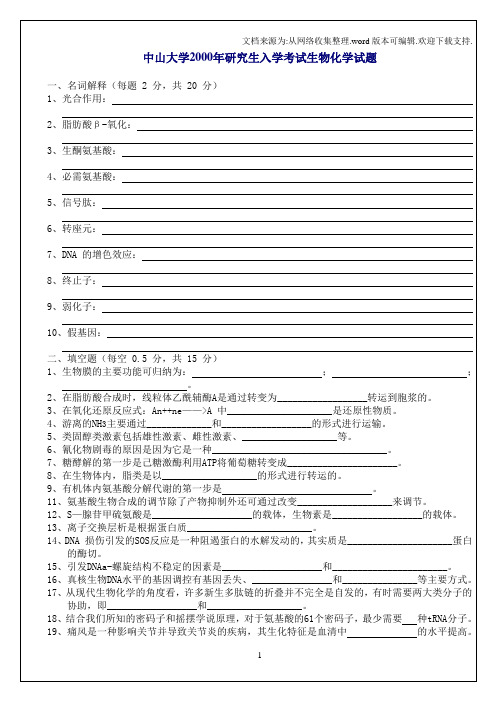
3、什么是生物固氮作用?生物固氮的意义何在?都血红蛋白在根瘤菌固氮中的作用是什么?
答:
4、生物保持物种稳定性和多样性的分子基础是什么?
答:
2、在脂肪酸合成时,线粒体乙酰辅酶A是通过转变为__________________转运到胞浆的。
3、在氧化还原反应式:An++ne——>A中_____________________是还原性物质。
4、游离的NH3主要通过_____________和__________________的形式进行运输。
20、( )与真核生物相比,原核生物 DNA 的复制速度比较慢。
四、简答题(任选 5 题,每题 5 分,共 25 分)
1、简述为什么C4植物比C3植物生长速度快,单位面积的生物量大?
答:
2、淀粉和纤维素都是有葡萄糖组成的?为什么人只能消化淀粉而同为辅乳动物的牛羊等食草动物却能以纤维素为食?
答:
3、严重的胆结石病人要将胆囊切除,为什么胆囊切除的病人不能吃太多油脂类食物?
14、DNA损伤引发的SOS反应是一种阻遏蛋白的水解发动的,其实质是_____________________蛋白的酶切。
15、引发DNAa-螺旋结构不稳定的因素是____________________和_______________________。
16、真核生物DNA水平的基因调控有基因丢失、________________和_______________等主要方式。
5、类固醇类激素包括雄性激素、雌性激素、___________________等。
6、氰化物剧毒的原因是因为它是一种___________________________________。
7、糖酵解的第一步是己糖激酶利用ATP将葡萄糖转变成______________________。
中山大学考研《生物化学》生化试卷
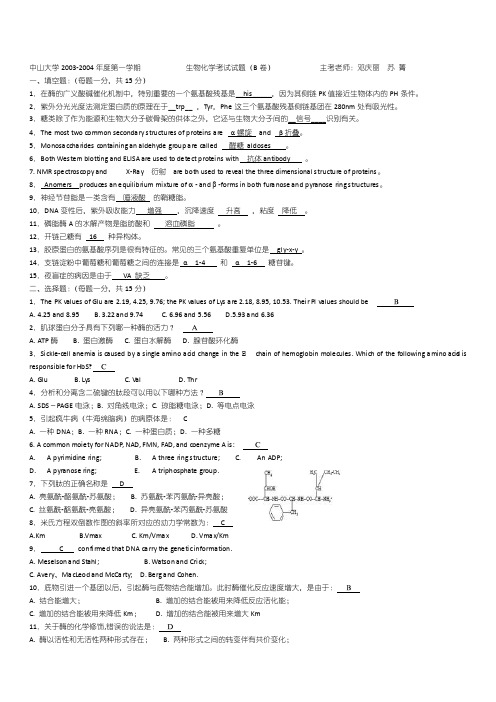
中山大学2003-2004年度第一学期生物化学考试试题(B卷)主考老师:邓庆丽苏菁一、填空题:(每题一分,共15分)1.在酶的广义酸碱催化机制中,特别重要的一个氨基酸残基是__his_____,因为其侧链PK值接近生物体内的PH条件。
2.紫外分光光度法测定蛋白质的原理在于__trp__ ,Tyr,Phe这三个氨基酸残基侧链基团在280nm处有吸光性。
3.糖类除了作为能源和生物大分子碳骨架的供体之外,它还与生物大分子间的__信号____识别有关。
4.The most two common secondary structures of proteins are α螺旋and β折叠。
5.Monosaccharides containing an aldehy de group are called 醛糖aldoses 。
6.Both Western blotting and ELISA are used to detect proteins with 抗体antibody 。
7. NMR spectroscopy and X-Ray 衍射are both used to reveal the three dimensional structure of proteins。
8.Anomers produces an equilibrium mixture of α - and β -forms in both furanose and pyranose ring structures。
9.神经节苷脂是一类含有唾液酸的鞘糖脂。
10.DNA变性后,紫外吸收能力增强,沉降速度升高,粘度降低。
11.磷脂酶A的水解产物是脂肪酸和溶血磷脂。
12.开链己糖有16 种异构体。
13.胶原蛋白的氨基酸序列是很有特征的。
常见的三个氨基酸重复单位是gly-x-y 。
14.支链淀粉中葡萄糖和葡萄糖之间的连接是α 1-4 和α 1-6 糖苷键。
中山大学生化真题1999-2022
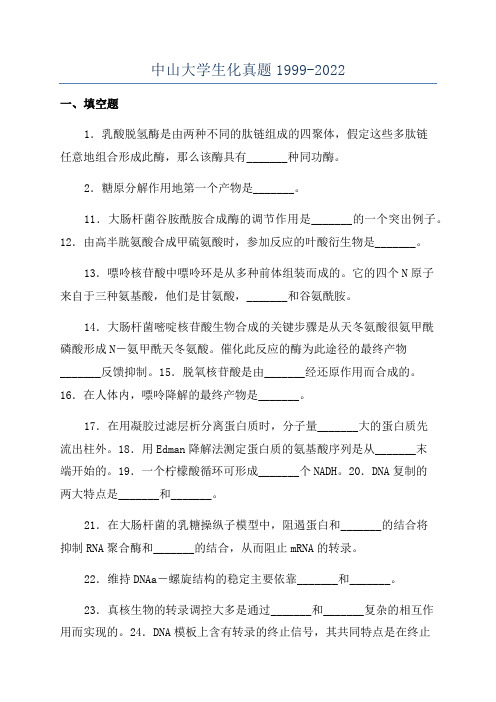
中山大学生化真题1999-2022一、填空题1.乳酸脱氢酶是由两种不同的肽链组成的四聚体,假定这些多肽链任意地组合形成此酶,那么该酶具有_______种同功酶。
2.糖原分解作用地第一个产物是_______。
11.大肠杆菌谷胺酰胺合成酶的调节作用是_______的一个突出例子。
12.由高半胱氨酸合成甲硫氨酸时,参加反应的叶酸衍生物是_______。
13.嘌呤核苷酸中嘌呤环是从多种前体组装而成的。
它的四个N原子来自于三种氨基酸,他们是甘氨酸,_______和谷氨酰胺。
14.大肠杆菌嘧啶核苷酸生物合成的关键步骤是从天冬氨酸很氨甲酰磷酸形成N-氨甲酰天冬氨酸。
催化此反应的酶为此途径的最终产物_______反馈抑制。
15.脱氧核苷酸是由_______经还原作用而合成的。
16.在人体内,嘌呤降解的最终产物是_______。
17.在用凝胶过滤层析分离蛋白质时,分子量_______大的蛋白质先流出柱外。
18.用Edman降解法测定蛋白质的氨基酸序列是从_______末端开始的。
19.一个柠檬酸循环可形成_______个NADH。
20.DNA复制的两大特点是_______和_______。
21.在大肠杆菌的乳糖操纵子模型中,阻遏蛋白和_______的结合将抑制RNA聚合酶和_______的结合,从而阻止mRNA的转录。
22.维持DNAa-螺旋结构的稳定主要依靠_______和_______。
23.真核生物的转录调控大多是通过_______和_______复杂的相互作用而实现的。
24.DNA模板上含有转录的终止信号,其共同特点是在终止信号前常有一个具有_______结构的富含GC区域,使转录的RNA自身有互补性,可形成发夹结构。
25.大肠杆菌RNA聚合酶有多个亚基组成,其中δ因子的作用仅表现在转录的_______阶段。
26.一般可通过等电聚焦电泳来测定蛋白质的_______。
27.维生素_______通过参与构成转氨酶的辅酶协助氨基酸的转移。
中山大学生化上考试往年试题完整版2008
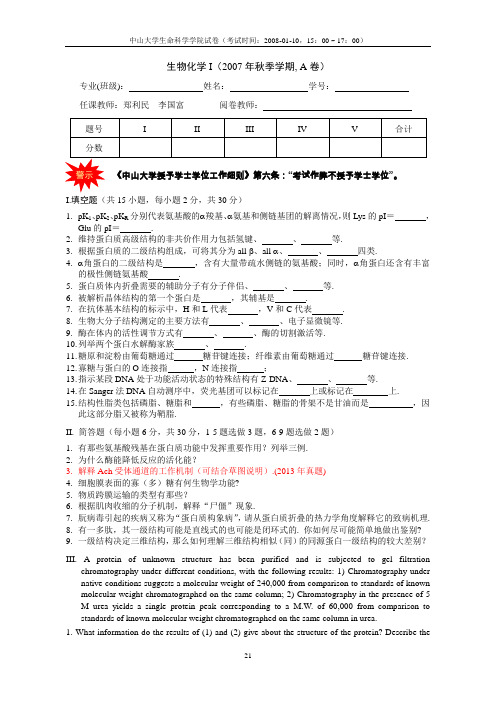
生物化学I (2007年秋季学期, A 卷)专业(班级): 姓名: 学号:任课教师:郑利民 李国富 阅卷教师:《中山大学授予学士学位工作细则》第六条:“考试作弊不授予学士学位”。
I.填空题(共15小题,每小题2分,共30分)1. pK 1、pK 2、pK R 分别代表氨基酸的α羧基、α氨基和侧链基团的解离情况,则Lys 的pI = ,Glu 的pI = .2. 维持蛋白质高级结构的非共价作用力包括氢键、 、 等.3. 根据蛋白质的二级结构组成,可将其分为all β、all α、 、 四类.4. α角蛋白的二级结构是 ,含有大量带疏水侧链的氨基酸;同时,α角蛋白还含有丰富的极性侧链氨基酸 .5. 蛋白质体内折叠需要的辅助分子有分子伴侣、 、 等.6. 被解析晶体结构的第一个蛋白是 ,其辅基是 .7. 在抗体基本结构的标示中,H 和L 代表 ,V 和C 代表 .8. 生物大分子结构测定的主要方法有 、 、电子显微镜等.9. 酶在体内的活性调节方式有 、 、酶的切割激活等.10. 列举两个蛋白水解酶家族 、 .11. 糖原和淀粉由葡萄糖通过 糖苷键连接;纤维素由葡萄糖通过 糖苷键连接.12. 寡糖与蛋白的O 连接指 ,N 连接指 ;13. 指示某段DNA 处于功能活动状态的特殊结构有Z-DNA 、 、 等.14. 在Sanger 法DNA 自动测序中,荧光基团可以标记在 上或标记在 上.15. 结构性脂类包括磷脂、糖脂和 ,有些磷脂、糖脂的骨架不是甘油而是 ,因此这部分脂又被称为鞘脂.II. 简答题(每小题6分,共30分,1-5题选做3题,6-9题选做2题)1.有那些氨基酸残基在蛋白质功能中发挥重要作用?列举三例. 2.为什么酶能降低反应的活化能? 3.解释Ach 受体通道的工作机制(可结合草图说明).(2013年真题) 4.细胞膜表面的寡(多)糖有何生物学功能? 5.物质跨膜运输的类型有那些? 6.根据肌肉收缩的分子机制,解释“尸僵”现象. 7.朊病毒引起的疾病又称为“蛋白质构象病”,请从蛋白质折叠的热力学角度解释它的致病机理. 8.有一多肽,其一级结构可能是直线式的也可能是闭环式的. 你如何尽可能简单地做出鉴别? 9. 一级结构决定三维结构,那么如何理解三维结构相似(同)的同源蛋白一级结构的较大差别? III. A protein of unknown structure has been purified and is subjected to gel filtrationchromatography under different conditions, with the following results: 1) Chromatography under native conditions suggests a molecular weight of 240,000 from comparison to standards of known molecular weight chromatographed on the same column; 2) Chromatography in the presence of 5 M urea yields a single protein peak corresponding to a M.W. of 60,000 from comparison to standards of known molecular weight chromatographed on the same column in urea.1. What information do the results of (1) and (2) give about the structure of the protein? Describe thestructure as completely as the data permit;2. On an SDS polyacrylamide gel, the pure proteinshows two stained bands. The relative mobilities ofthose 2 "unknown" bands are shown on the plotbelow as open circles (O), with the mobilities of 5known polypeptide standards of M.W. 15,000;20,000; 30,000, 40,000 and 50,000. Given the resultsof the SDS gel, how would you alter your descriptionof the protein structure from the description you gavein part 1? Be as specific as you can about yourrevised description of the structure, and explain thereason for the altered description.IV. Lysozyme destroys the cell wall of bacteria by catalyzing the hydrolysis of 1,4-β-linkages between N-acetylmuramic acid (NAM) and N-acetyl-D-glucosamine (NAG) residues in a peptidoglycan.Six hexoses of the substrate fit into the active site of lysozyme, a deep cleft across part of the globular protein surface this cleft. Figure A shows the hydrolytic process of 1,4-β-linkages between NAM and NAG and figure B shows the pH-activity profile of lysozyme. Please calculate the ratio of the enzyme molecules which really work at pH 3.8, 5.2, 6.6 to all enzyme molecules, and explain figure B according to your calculation (pH = pKa + lg([A-]/[HA]);pKa Glu = 5.9, pKa Asp =4.5;102.1≈126,100.7≈5).A B生物化学I(2006年秋季学期, A卷)专业(班级):姓名:学号:任课教师:郑利民李国富阅卷教师:题号I II III IV V VI 合计《中山大学授予学士学位工作细则》第六条:“考试作弊不授予学士学位”。
中山大学生化真题专项整理(含答案)8糖代谢
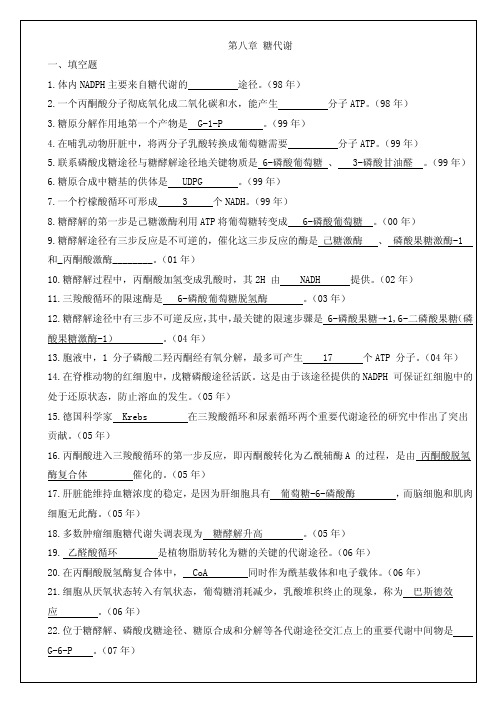
第八章糖代谢一、填空题1.体内NADPH主要来自糖代谢的途径。
(98年)2.一个丙酮酸分子彻底氧化成二氧化碳和水,能产生分子ATP。
(98年)3.糖原分解作用地第一个产物是 G-1-P 。
(99年)4.在哺乳动物肝脏中,将两分子乳酸转换成葡萄糖需要分子ATP。
(99年)5.联系磷酸戊糖途径与糖酵解途径地关键物质是 6-磷酸葡萄糖、 3-磷酸甘油醛。
(99年)6.糖原合成中糖基的供体是 UDPG 。
(99年)7.一个柠檬酸循环可形成 3 个NADH。
(99年)8.糖酵解的第一步是己糖激酶利用ATP将葡萄糖转变成 6-磷酸葡萄糖。
(00年)9.糖酵解途径有三步反应是不可逆的,催化这三步反应的酶是己糖激酶、磷酸果糖激酶-1 和_丙酮酸激酶________。
(01年)10.糖酵解过程中,丙酮酸加氢变成乳酸时,其2H 由 NADH 提供。
(02年)11.三羧酸循环的限速酶是 6-磷酸葡萄糖脱氢酶。
(03年)12.糖酵解途径中有三步不可逆反应,其中,最关键的限速步骤是 6-磷酸果糖→1,6-二磷酸果糖(磷酸果糖激酶-1)。
(04年)13.胞液中,1 分子磷酸二羟丙酮经有氧分解,最多可产生 17 个ATP 分子。
(04年)14.在脊椎动物的红细胞中,戊糖磷酸途径活跃。
这是由于该途径提供的NADPH 可保证红细胞中的处于还原状态,防止溶血的发生。
(05年)15.德国科学家 Krebs 在三羧酸循环和尿素循环两个重要代谢途径的研究中作出了突出贡献。
(05年)16.丙酮酸进入三羧酸循环的第一步反应,即丙酮酸转化为乙酰辅酶A 的过程,是由丙酮酸脱氢酶复合体催化的。
(05年)17.肝脏能维持血糖浓度的稳定,是因为肝细胞具有葡萄糖-6-磷酸酶,而脑细胞和肌肉细胞无此酶。
(05年)18.多数肿瘤细胞糖代谢失调表现为糖酵解升高。
(05年)19. 乙醛酸循环是植物脂肪转化为糖的关键的代谢途径。
(06年)20.在丙酮酸脱氢酶复合体中, CoA 同时作为酰基载体和电子载体。
(整理)中山大学生化真题版年生物化学.
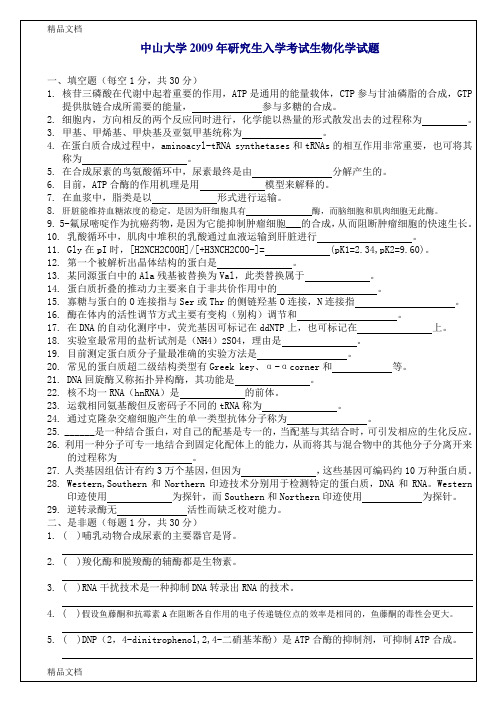
25. ______是一种结合蛋白,对自己的配基是专一的,当配基与其结合时,可引发相应的生化反应。
26.利用一种分子可专一地结合到固定化配体上的能力,从而将其与混合物中的其他分子分离开来的过程称为。
27.人类基因组估计有约3万个基因,但因为,这些基因可编码约10万种蛋白质。
(2)评价方法的适当性;
2.辨识与分析危险、有害因素
环境,是指影响人类生存和发展的各种天然的和经过人工改造的自然因素的总体。9.原核生物与真核生物基因组结构方面有哪些主要差别?
答:
(五)规划环境影响评价的跟踪评价
《建设项目安全设施“三同时”监督管理暂行办法》(国家安全生产监督管理总局令第36号)第四条规定建设项目安全设施必须与主体工程“同时设计、同时施工、同时投入生产和使用”。安全设施投资应当纳入建设项目概算。并规定在进行建设项目可行性研究时,应当分别对其安全生产条件进行论证并进行安全预评价。
答:
2.为什么说PRPP(5-Phosphoribosyl-1-pyrophosphate,1-焦磷酸-5-磷酸核糖)是核苷酸合成途径的重要原料?
答:
3.机体中,代谢是一个复杂而又高度整合的化学反应的网络,体现着一些基本的原理和规律。简述你所知道的代谢途径的两个基本规律。
答:
4.人死后,大约经过1-3小时,肌肉轻度收缩,关节不能曲屈,开始出现尸僵;经过12-16小时,尸僵遍及全身。请根据肌肉收缩的分子机制,解释“尸僵”现象。
14. ( )SDS-PAGE时,不同大小蛋白质分子的电荷/质量比值趋近于相同。
15. ( )酶可以降低反应的活化能,因此它能使热力学上不能发生的反应在生物体内进行。
16. ( )活细胞中tRNA的空间结构呈“三叶草”型。
中山大学生物化学(一)真题
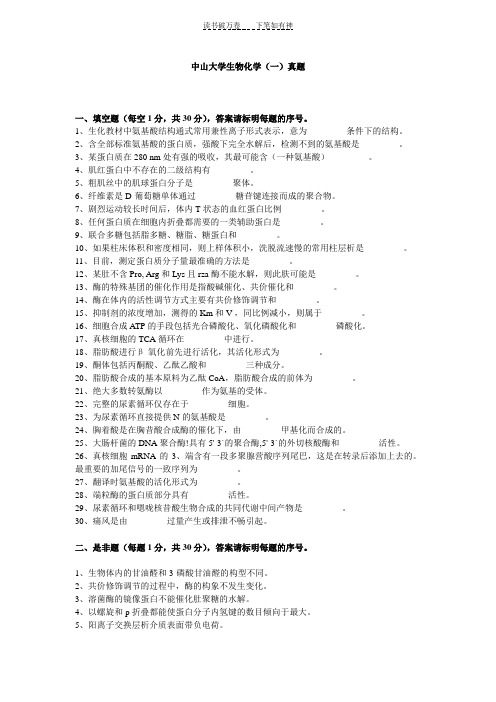
中山大学生物化学(一)真题一、填空题(每空1分,共30分),答案请标明每题的序号。
1、生化教材中氨基酸结构通式常用兼性离子形式表示,意为_________条件下的结构。
2、含全部标准氨基酸的蛋白质,强酸下完全水解后,检测不到的氨基酸是_________。
3、某蛋白质在280 nm处有强的吸收,其最可能含(一种氨基酸)_________。
4、肌红蛋白中不存在的二级结构有_________。
5、粗肌丝中的肌球蛋白分子是_________聚体。
6、纤维素是D-葡萄糖单体通过_________糖苷键连接而成的聚合物。
7、剧烈运动较长时间后,体内T状态的血红蛋白比例_________。
8、任何蛋白质在细胞内折叠都需要的一类辅助蛋白是_________。
9、联合多糖包括脂多糖、糖脂、糖蛋白和_________。
10、如果柱床体积和密度相同,则上样体积小,洗脱流速慢的常用柱层析是_________。
11、目前,测定蛋白质分子量最准确的方法是_________。
12、某肚不含Pro, Arg和Lys且rza酶不能水解,则此肤可能是_________。
13、酶的特殊基团的催化作用是指酸碱催化、共价催化和_________。
14、酶在体内的活性调节方式主要有共价修饰调节和_________。
15、抑制剂的浓度增加,测得的Km和V-,同比例减小,则属于_________。
16、细胞合成ATP的手段包括光合磷酸化、氧化磷酸化和_________磷酸化。
17、真核细胞的TCA循环在_________中进行。
18、脂肪酸进行β-氧化前先进行活化,其活化形式为_________。
19、酮体包括丙酮酸、乙酞乙酸和_________三种成分。
20、脂肪酸合成的基本原料为乙酞CoA,脂肪酸合成的前体为_________。
21、绝大多数转氨酶以_________作为氨基的受体。
22、完整的尿素循环仅存在于_________细胞。
23、为尿素循环直接提供N的氨基酸是_________。
- 1、下载文档前请自行甄别文档内容的完整性,平台不提供额外的编辑、内容补充、找答案等附加服务。
- 2、"仅部分预览"的文档,不可在线预览部分如存在完整性等问题,可反馈申请退款(可完整预览的文档不适用该条件!)。
- 3、如文档侵犯您的权益,请联系客服反馈,我们会尽快为您处理(人工客服工作时间:9:00-18:30)。
生物化学I (2007年秋季学期, A 卷)专业(班级): 姓名: 学号:任课教师:郑利民 李国富 阅卷教师:《中山大学授予学士学位工作细则》第六条:“考试作弊不授予学士学位”。
I.填空题(共15小题,每小题2分,共30分)1. pK 1、pK 2、pK R 分别代表氨基酸的α羧基、α氨基和侧链基团的解离情况,则Lys 的pI = ,Glu 的pI = .2. 维持蛋白质高级结构的非共价作用力包括氢键、 、 等.3. 根据蛋白质的二级结构组成,可将其分为all β、all α、 、 四类.4. α角蛋白的二级结构是 ,含有大量带疏水侧链的氨基酸;同时,α角蛋白还含有丰富的极性侧链氨基酸 .5. 蛋白质体内折叠需要的辅助分子有分子伴侣、 、 等.6. 被解析晶体结构的第一个蛋白是 ,其辅基是 .7. 在抗体基本结构的标示中,H 和L 代表 ,V 和C 代表 .8. 生物大分子结构测定的主要方法有 、 、电子显微镜等.9. 酶在体内的活性调节方式有 、 、酶的切割激活等.10. 列举两个蛋白水解酶家族 、 .11. 糖原和淀粉由葡萄糖通过 糖苷键连接;纤维素由葡萄糖通过 糖苷键连接.12. 寡糖与蛋白的O 连接指 ,N 连接指 ;13. 指示某段DNA 处于功能活动状态的特殊结构有Z-DNA 、 、 等.14. 在Sanger 法DNA 自动测序中,荧光基团可以标记在 上或标记在 上.15. 结构性脂类包括磷脂、糖脂和 ,有些磷脂、糖脂的骨架不是甘油而是 ,因此这部分脂又被称为鞘脂.II. 简答题(每小题6分,共30分,1-5题选做3题,6-9题选做2题)1.有那些氨基酸残基在蛋白质功能中发挥重要作用?列举三例. 2.为什么酶能降低反应的活化能? 3.解释Ach 受体通道的工作机制(可结合草图说明). 4.细胞膜表面的寡(多)糖有何生物学功能? 5.物质跨膜运输的类型有那些? 6.根据肌肉收缩的分子机制,解释“尸僵”现象. 7.朊病毒引起的疾病又称为“蛋白质构象病”,请从蛋白质折叠的热力学角度解释它的致病机理. 8.有一多肽,其一级结构可能是直线式的也可能是闭环式的. 你如何尽可能简单地做出鉴别? 9. 一级结构决定三维结构,那么如何理解三维结构相似(同)的同源蛋白一级结构的较大差别? III. A protein of unknown structure has been purified and is subjected to gel filtrationchromatography under different conditions, with the following results: 1) Chromatography under native conditions suggests a molecular weight of 240,000 from comparison to standards of known molecular weight chromatographed on the same column; 2) Chromatography in the presence of 5 M urea yields a single protein peak corresponding to a M.W. of 60,000 from comparison to standards of known molecular weight chromatographed on the same column in urea.1. What information do the results of (1) and (2) give about the structure of the protein? Describe thestructure as completely as the data permit;2. On an SDS polyacrylamide gel, the pure proteinshows two stained bands. The relative mobilities ofthose 2 "unknown" bands are shown on the plotbelow as open circles (O), with the mobilities of 5known polypeptide standards of M.W. 15,000;20,000; 30,000, 40,000 and 50,000. Given the resultsof the SDS gel, how would you alter your descriptionof the protein structure from the description you gavein part 1? Be as specific as you can about yourrevised description of the structure, and explain thereason for the altered description.IV. Lysozyme destroys the cell wall of bacteria by catalyzing the hydrolysis of 1,4-β-linkages between N-acetylmuramic acid (NAM) and N-acetyl-D-glucosamine (NAG) residues in a peptidoglycan.Six hexoses of the substrate fit into the active site of lysozyme, a deep cleft across part of the globular protein surface this cleft. Figure A shows the hydrolytic process of 1,4-β-linkages between NAM and NAG and figure B shows the pH-activity profile of lysozyme. Please calculate the ratio of the enzyme molecules which really work at pH 3.8, 5.2, 6.6 to all enzyme molecules, and explain figure B according to your calculation (pH = pKa + lg([A-]/[HA]);pKa Glu = 5.9, pKa Asp =4.5;102.1≈126,100.7≈5).A B生物化学I(2006年秋季学期, A卷)专业(班级):姓名:学号:任课教师:郑利民李国富阅卷教师:题号I II III IV V VI 合计《中山大学授予学士学位工作细则》第六条:“考试作弊不授予学士学位”。
I.简答题(共25小题,每小题4分,超过50分以50分计入总分)1.哪些标准氨基酸含两个手性碳原子?写出它们的Fisher 投影式。
(4′)2.为什么SDS 变性电泳可以估算蛋白质的分子量?(4′)3.Mass spectroscopy 在生物大分子研究中有什么应用?(4′)4. -Keratin 、Collagen 、Silk fibroin 的二级结构和氨基酸组成有何特点?(4′)5.根据二级结构的组成和排列可将蛋白质结构分为哪些类型?(4′)6.蛋白质in vivo 条件下的折叠有哪些辅助因子?(4′)7.蛋白质在与其他分子的相互作用中发挥作用,这种相互作用有何特点?(4′)8.哪些因素可以导致Hemoglobin 与O 2的亲和力增加?(4′)9.图示抗体的一般结构(包括结构域及可能的二硫键)。
(4′)10.构成肌肉粗丝和细丝的蛋白分子有哪些,各有什么功能?(4′)11.写出蛋白质氨基酸测序的基本步骤。
(4′)12.什么是酶催化的过渡态理论?列出你所知道的支持证据?(4′)13.酶的可逆抑制剂有几类?它们的抑制动力学各有何特点?(4′)14.酶在体内的活性是如何受到调控的?(4′)15.淀粉与纤维素的结构有何区别?(4′)16.细胞膜表面的Glycoprotein 和Glycolipid 有哪些生物学功能?(4′)17.细胞内的DNA 可能会出现哪些异常结构,他们有什么生物学意义?(4′)18.膜脂的分类及其结构特点(4′)19.生物膜的功能有哪些?(4′)20.膜蛋白以哪些方式参与生物膜的构成?(4′)21.图示secondary active transport ,uniport ,symport ,antiport. (4′)22.Acetylcholine receptor 通道是如何控制开关的?(4′)23.K +离子通道是如何对通过的离子进行选择的?(4′)24.膜电位是怎样控制Na +通道开关的(可图示并说明)?(4′)25.Ca 2+泵和Na +-K +泵的异同点。
(4′)II. You have a crude lysate sample containing a mixture of six proteins (1, 2, 3, 4, 5, andβ-galactosidase). Some characteristics of these proteins are shown in the table below. Give an available procedure of purifying β-galactosidase. (10 pts)III. You are working on a compound as a potential drug that inhibits an overproducedenzyme whose uncontrolled activity leads to uncontrolled cell proliferation (cancer). A steady-state kinetic analysis of the enzyme-catalyzed reaction was carried out, with velocities measured as a function of the concentration of the substrate in the absence and in the presence of 10 nM inhibitor. Theresults of the kinetics experiment are plotted for you below. Please answer the following questions. (10 pts)1. What type of inhibitor is this compound (be as specific as you can)? Show thediagram of the inhibitor ’s mechanism (by E denoting enzyme, S denoting substrate, I denoting inhibitor; for example: ).2. Calculate the K m , K cat in the absence of inhibitor and K m app , K cat app in the presenceof inhibitor (app denoting apparent. The total concentration of enzyme is 2nM).3. Calculate the inhibitor constant K I .IV. Lysozyme destroys the cell wall of bacteria by catalyzing the hydrolysis of1,4-β-linkages between N-acetylmuramic acid (NAM) and N-acetyl-D-glucosamine (NAG) residues in a peptidoglycan (figure A). Figure B shows the binding of the peptidoglycan to the active site of lysozyme, a deep cleft across part of the globular protein surface. Six hexoses of the substrate fit into this cleft. Figure C shows the hydrolytic process of 1,4-β-linkages between NAM and NAG and figure D shows the pH-activity profile of lysozyme. Please answer the following questions. (10 pts)1. What can you talk about the figure B in accord with the enzymatic mechanism?2. What can you talk about the figure C in accord with the enzymatic mechanism?3.Calculate the ratio of the enzyme molecules which really work at pH3.8, 5.2, 6.6 toall enzyme molecules, and explain figure D according to your calculation (pH = pKa + lg([A-]/[HA]);pKa Glu = 5.9, pKa Asp = 4.5;102.1≈126,100.7≈5).Figure CFigure AFigure BFigure DName Class ScoreBiochemistry (I) Final Exam (fall, 2004)NOTE: You must write your answer on the answer sheet!Part I: For the following multiple choice questions, one answer is most appropriate (2.5 18 = 45 points).1. With regard to amino acids, which statement is false?A) Amino acids can act as proton donors and acceptors.B) All amino acids discovered in organism are L enantiomers.C) An L amino acid can be Dextrorotary.D) A conjugate acid/base pair is at its greatest buffering capacity whenthe pH equals its pK.E) Non-standard amino acids can be found in the hydrolysis product of aprotein.2. A mixture of Ala, Arg, and Asp in a pH 5.5 buffer was placed on a cationexchange column (the column is negatively charged) and eluted with the same buffer. What is the order of elution from the column? Use these pK a values: terminal COOH - 2, terminal NH3+- 9, R-amino - 10, R-COOH - 3A) Arg, Ala then AspB) Arg, Asp then AlaC) Asp, Ala then ArgD) Asp, Arg then AspE) Ala, Asp then Arg3. Proteins can be chromatographically separated by their differentA) Charge.B) Molecular weight.C) Hydrophobicity.D) Affinity for other molecules.E) All of above.4. A peptide was found to have a molecular mass of about 650 and uponhydrolysis produced Ala, Cys, Lys, Phe, and Val in a 1:1:1:1:1 ratio. The peptide upon treatment with Sanger's reagent (FDNB) produced NP-Cys and exposure to carboxypeptidase produced valine. Chymotrypsin treatment of the peptide produced a dipeptide that contained sulfur andhas a UV absorbance, and a tripeptide. Exposure of the peptide to trypsin produced a dipeptide and a tripeptide. The sequence of the peptide isA) val-ala-lys-phe-cysB) cys-lys-phe-ala-valC) cys-ala-lys-phe-valD) cys-phe-lys-ala-valE) val-phe-lys-ala-cys5. With regard to protein structure, which statement is false?A) The dominant force that drives a water-soluble protein to fold ishydrophobic interaction.B) The number of hydrogen bonds within a protein intends to beminimized.C) The conformations of a native protein are possibly the lowest energystate.D) The conformations of a native protein are countless.E) Disulfde bridges can increase the stability of a protein.6. Which structure is unique to collagen?A) The alpha helix.B) The double helix.C) The triple helix.D) The beta structure.E) The beta barrel.7. Which protein has quaternary structure?A) Insulin.B) A natural antibody.C) Chymotrypsin.D) Aspartate transcarbamoylase (ATCase).E) Myoglobin.8. Which of the following are "broad themes used in discussing enzymereaction mechanisms"?A) Proximity stabilizationB) Transition state stabilizationC) Acid-base catalysisD) Covalent catalysisE) All of the above9. Under physiological conditions, which of the following processes is not animportant method for regulating the activity of enzymes?A) PhosphorylationB) Temperature changesC) AdenylationD) Allosteric regulationE) Protein processing10. The conversion of glucose to pyruvate is a multistep process requiring tenenzymes. If a mutation occurs resulting in a lack of activity for one of these enzymes, which of the following happens?A) The concentration of the metabolic intermediate which is the substrateof the missing enzyme is likely to increase and accumulateB) The concentration of pyruvate will increaseC) The cell will produce more of the other nine enzymes to maintainsteady stateD) The concentration of the metabolic intermediate which is the productof the missing enzyme will decreaseE) A and D11. Indicate which is true about enzymes.A) Enzymes are permanently changed during the conversion of substrateinto product.B) Enzymes interact irreversibly with their substrates.C) Enzymes change the energy difference between substrates andproducts.D) Enzymes reduce the energy of activation for the conversion of reactantinto product.E) Enzymes increase the energy content of the products.12. Consider a reaction as follows:A +B <====>C + D, ΔG'0 = +10.0 Kj/molHow can this reaction go forward?A) Coupling of this reaction to a highly exergonic reaction through acommon intermediate.B) Immediate removal of the products.C) Addition of the appropriate enzyme.D) A and B.E) All of the above.13. Which statement is not true of enzyme inhibitors?A) A competitive inhibitor binds the active site of the enzyme.B) Allosteric enzymes exhibit Michaelis-Menton kinetics.C) A noncompetitive enzyme binds elsewhere than the active site.D) Noncompetitive inhibitors cannot be completely overcome by addingmore substrate.E) Competitive inhibition can be completely overcome by adding moresubstrate.14. You could most dramatically destabilize a duplex DNA molecule in anaqueous solution byA) Decreasing the temperature.B) Decreasing the concentration of salt.C) Decreasing the concentration of organic solvents.D) Adjusting the pH to a value near 7.E) Adding a detergent.15. With regard to DNA, which statement is false?A) Triple helix and tetraplex tend to appear at sites where replication,recombination or transcription is initiated or regulated.B) Hydrogen bonds are the only force to stabilize DNA structure.C) The absorbance of DNA at 260 nm will rise when it is denatured.D) Z-DNA tracts may play an role in the regulation of the expression ofsome genes or in genetic recombination.E) B-DNA is the most stable structure in physiological condition.16. With regard to biological membrane, which statement is false?A) The ratio of proteins to lipids is various in different membranes.B) The membrane with more proteins has more complicated function thanthat with fewer proteins.C) Each membrane has a characteristic composition of lipids.D) Lipids symmetrically distribute in the two leaflets of a membrane.E) The flip-flop movement of lipids is done by a kind of enzyme.17. Which of the following statements are true about the interactions betweensubstrate and active site? You can assume that the catalysis goes to completion.① Catalytic residues can be affected by pH② The majority of bonds in E-S interactions are covalent bonds such asdisulfide and peptide bonds③The components of a mixture of the two mirror-image isomers of acompound, called a racemic mixture, will be acted upon equally byan enzyme④ The active site can alter itself to better fit the substrate⑤ The active site is permanently altered by its interaction with substrate⑥ The substrate is permanently altered by its interaction with active site⑦ Competitive inhibitors have no affect on the active siteA) ①, ②, ③B) ②, ④, ⑤C) ③, ④, ⑤D) ②, ④, ⑦E) ①, ④, ⑥18. Which of the following statements refer to glycogen ("G") and whichrefer to cellulose ("C")?① Contains beta-1,4 glycosidic bonds② Cannot be digested by mammalian enzymes③ Straight-chain molecule of high tensile strength④ Contains alpha 1,6-glycosidic bonds⑤ Branched molecule⑥ Used as a structural component⑦ Used as a nutritional storage moleculeA) G= ①, ④, ⑦; C= ②, ③, ⑤, ⑥B) G= ④, ⑤, ⑦; C= ①, ②, ③, ⑥C) G= ②, ③, ④, ⑥; C= ①, ⑤, ⑦D) G= ⑤, ⑥; C= ①, ②, ③, ④, ⑦E) G= ①, ②, ④; C= ③, ⑤, ⑥,⑦Part II:According to the figures and conditions provided, fill the blanks (Fewer have two or more answers, 55 points).19. Protein secondary structures and their organization (5 points).A)Parallel β-pleated sheet;B)Antiparallel β-pleated sheet;C)Residues of Pro and Gly;D)Residues of Pro and Val;E)Residues of hydrophilic amino acids;F)Residues of hydrophobic amino acids;G)Residue of Arg, Lys, or His;H)Residue of Asp, or Glu.a)One domain of the protein is composed ofb)What amino acids are frequently found in 5c)If the residues at 6 is positively charged, then the residue at 7 is bestd)What residues occur mostly at 1 and 2?e)What residues occur mostly at 3 and 4?20. Several oxygen dissociation curves are shown in the following figure. (5points).Assume that curve C corresponds to purified hemoglobin placed in a solution containing physiological concentrations of CO2 and BPG at a pH of 7.0. Below, indicate which of the curves reflects the changes noted in physiological conditions by placing the curve # on the lines below (Use only one curve choice/physiological change):a. Decreased CO2 concentration______________b. Increase BPG concentration_______________c. Dissociation of hemoglobin into subunitsd. A mutation that eliminates ion pairs that stabilize the T ordeoxygenated statee. Fetal hemoglobin or a mutation which increase binding affinity foroxygen21. Supersecondary structure of proteins (5 points).A) β-α-β Loop;B) Greek Key;C) α-α Corner;D) Right-handed connection between β strands;E) Not observed;F) Very rare.a. b. c. Dd. e. f.22. Protein classification (5 points).A) All α; B) All β: C) α/β; D) α+β; E) Superfamily; F) Speciesa. Ad. e. f.23. Kinetics of enzyme inhibition or double-substrate reaction (5 points).a. Competitive inhibition Ab. Non-competitive inhibitionc. Uncompetitive inhibitiond. Mixed competitive inhibitionIf [S2] and ↓ substitute for [I] and ↑ respectively, then:e. Double-substrate enzyme reaction involving a ternary complexf. Double-substrate enzyme reaction with a ping-pong mechanism24. Structure about Nucleotides and DNA (5 points)a.Exo-2´ / Endo-2´configuration of riboseb.Exo-3´ / Endo-3´configuration of ribosec.Hoogsteen Pairsd.Can form cruciform structuree.Can form H-DNA25. Biomembrane lipids (5 points)a.Sphingolipidsb.Phospholipase A1c.Phospholipase A2d.Phospholipase Ce.Sphingosine26. Classes of membrane transports (5 points)a.Passive-transporters Cb.Primary Active transportc.Secondary Active transportd.Channelse.Pumpsf.Active co-transporters27. Mechanism of Ach-gated ion channel (left, a cross section at the gate) orvoltage-gated Na+ channel (right, vertical views).A)Inactive / activateable state of Na+ channel;B)Inactive / inactivateable state of Na+ channel;C)Inactivateable state of Na+ channel;D)Active state of Na+ channel;E)The 2nd tansmembrane helix of α, β, γ, or δ subunit;F)The 3rd tansmembrane helix of α, β, γ, or δ subunit;G)Small polar amino acid residue;H)Large non-polar amino acid residue;a)b)c)d) De)f)g) B28. Biosignalinga)Ligand-gated channel pathway Ab)Receptor enzyme pathwayc)G protein coupled pathway Cd)Nuclear receptor pathwaye)The pathway(s) can act in synapse transmission Af)The pathway(s) can regulate gene expressiong)The pathway(s) can regulate the concentration of glucose in bloodh)It can phosphorylate Tyr, Ser, or Thr of proteinsi)Molecules including cAMP, cGMP, IP3 etc.j)This signal molecule may be Ach Ek)This signal molecule is usually a steroid hormonel)This signal molecule may be insulinm)This signal molecule may be epinephrine Gn)The subunit(s) of G protein is(are) very conservativeo)The subunit(s) of G protein is (are) variousp)The subunit(s) of G protein can bind GDP >P LAnswer Sheet for Biochemistry (I) Final Exam (fall, 2004) Name Class ScorePart I1. 2. 3. 4. 5.6. 7. 8. 9. 10.11. 12. 13. 14. 15.16. 17. 18.Part II19: a) b) c) d) e)20: a) b) c) d) e)21: a) b) c) D d) e)f)22: a) a b) c) d) e)f)23: a) a b) c) d) e)f)24: a) b) c) d) e)25: a) b) c) d) e)26: a) c b) c) d) e)f)27: a) b) c) d) D e)f) g) B28: a) A b) c) C d) e) Af) g) h) i) j) Ek) l) m) G n) o)p) L生物化学I (2008年秋季学期, A 卷)1. Lysozyme destroys the cell wall of bacteria by catalyzing the hydrolysis of 1,4-β-linkages between N-acetylmuramic acid (NAM) and N-acetyl-D-glucosamine (NAG) residues in a peptidoglycan.. Figure A shows the hydrolytic process of 1,4-β-linkages between NAM and NAG, and figure B shows the pH-activity profile of lysozyme. (1) Describe figure A related to the catalytic mechanism of enzyme; (2) Calculate the ratio of the enzyme molecules which really work at pH 5.2 to all enzyme molecules, and say some thing possible for why it is not of 100% at the optimal pH (pH = pKa + lg([A -]/[HA]); pKa Glu = 5.9, pKa Asp = 4.5;100.7≈5; 12 points).(1)图1显示溶菌酶水解peptidoglycan 中的糖苷键时的酸碱催化和共价催化机理【1分】,其中Glu-35起酸催化和共价催化作用【2分】,Asp-52起碱催化作用【2分】(2)分子比例:【方法正确但计算错误得3分,方法和计算均正确得5分】lg([Asp-]/[HAsp]) = pH – pKa = 5.2 – 4.5 = 0.7,[Asp-]/[HAsp] = 5起碱作用的Asp 所占比例: [Asp-] /([HAsp]+[Asp-])= [Asp-]/( [Asp-]/5+[Asp-])= 5/6 lg([Glu-]/[HGlu]) = pH – pKa = 5.2–5.9 = -0.7,[Glu-]/[HGlu] = 1/5起酸作用的Glu 所占比例: [HGlu]/([HGlu]+[Glu-])= [HGlu]/([HGlu]+[HGlu] /5)= 5/6 真正能工作的酶分子比例=(5/6)×(5/6)≈ 69.4%(3) pH5.2是该酶的最佳pH 值,但工作的酶分子比例仅为69.4%而非100%。
